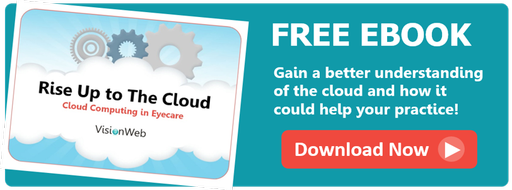Practice Management Solutions for Eye Care Practices

There's plenty of hype about cloud computing these days, but it's not exactly a new concept. We thought that it would be interesting to explore how cloud computing can be used in new and different ways, especially as a practice management solution for eye care practices.
We asked our friends at VitalHealth, a leader in cloud-based EHR software designed with Mayo Clinic, to give their insight on cloud computing.
Cloud Computing as an Eyecare Practice Management Software Solution
Some of our readers may be wondering if the time has arrived to replace their current clinical and practice management software with a more modern solution. There can be any number of reasons for taking that step. Perhaps you’d like to benefit from Meaningful Use reimbursements, and you’re looking for certified EHR technology. Or perhaps your eyecare practice management software simply can’t keep up with your desire to embrace mobile technologies. Whatever your reason may be, perhaps you’re wondering if “cloud computing” should be one of these reasons?
In this blog post we’ll try to explain what cloud computing is, and why you should seriously consider going that route. We’ll also try to alleviate some of the concerns you may have, if any. So let’s get started.
What is Cloud Computing?
Cloud computing means running some of your IT infrastructure (applications and or data) in a location other than your own physical office. You access this infrastructure remotely via the Internet, but you don’t necessarily know exactly where your applications or data are residing physically. Their location is “fuzzy, indefinite, non-localized”, as if it is inside a “cloud”.
 Most of us probably already use some form of cloud computing, even though you may not realize it. For instance, if you access Google’s email service via a browser, you are using a “cloud email” solution. Perhaps you sync your email down to a local device such as your mobile phone. In that case your email application is ‘local’, but your email data is in the cloud.
Most of us probably already use some form of cloud computing, even though you may not realize it. For instance, if you access Google’s email service via a browser, you are using a “cloud email” solution. Perhaps you sync your email down to a local device such as your mobile phone. In that case your email application is ‘local’, but your email data is in the cloud.
Some of you may already be more advanced cloud users than you realize. Have you ever used Google Docs, or Microsoft’s Office 365? In that case you are a full-fledged cloud user already! You simply use a browser to run e.g. a word processor or spreadsheet application in the cloud, with no local installations of these applications on your computer required. You don’t know where the applications or your data physically reside. They’re somewhere…in the cloud.
What About Security?
The biggest concern typically voiced by cloud-skeptics is “security”. In reality, security of cloud-based applications usually far exceeds that of local infrastructures. Cloud vendors invest heavily in making sure that applications and data are protected from unauthorized access in the form of hackers, as well as physical access to the servers. They have implemented backup and disaster procedures that exceed anything you can afford to implement in a local infrastructure. While the idea of leaving your sensitive data in the hands of an outside vendor may be unsettling, the reality is that these vendors are extremely qualified to address your security concerns.
What About Cost?
Fair question. Typical monthly fees for cloud solutions may seem high at face value. But if you actually went through the exercise of spreading out local infrastructure costs over its lifespan, you would be surprised to find that cloud computing beats a local infrastructure hands-down. Besides that, a monthly subscription fee is much more predictable in terms of cash flow, compared to the typical high upfront costs and spikes in maintenance costs of a local infrastructure.
What Infrastructure Do You Need Locally?
For most cloud applications, you only need Internet access and wired or wireless devices that run any of the major browsers, like Google Chrome, FireFox, Safari, or Internet Explorer. Your bandwidth requirements will depend on your practice size, as well as the cloud applications you are trying to access. For most scenarios, a connection with about 1 Mbps of bandwidth per user is more than sufficient. Pair that with a small business router of a few hundred dollars to protect your network from external intruders, and you are all set.

Join The Cloud!
If we had to summarize the benefits of Cloud Computing in one short phrase, it would be ‘economies of scale’. By sharing an IT infrastructure, all subscribers share in the predictable costs of using a highly secure and reliable environment. What’s not to like? Time to join the migration to the cloud!
Want to learn more about using the cloud in your practice? Download our eBook, Rise Up to The Cloud: Cloud Computing in Eyecare.


